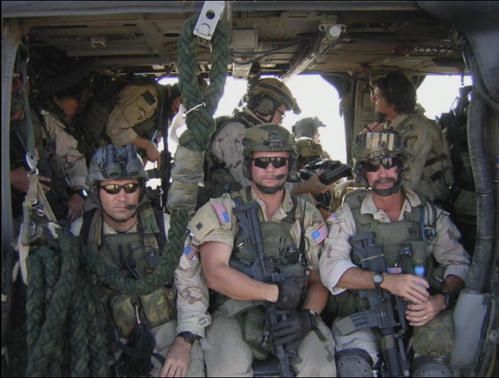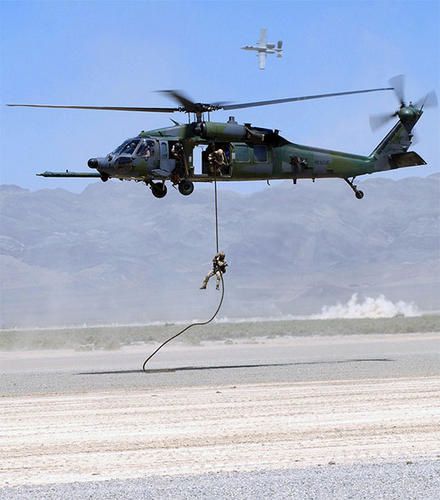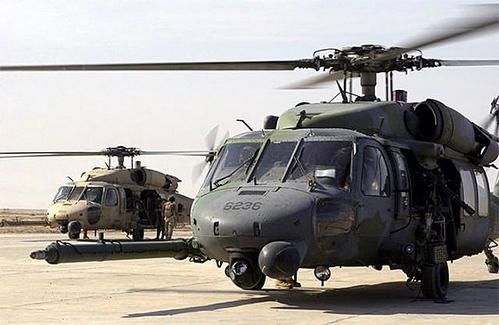

![]()

| U.S. MH-60G Pave Hawk™ |  |
Joint Special Operations Command (JSOC)
Joint Special Operations Command (JSOC) is officially described as a "joint headquarters designed to study special operations requirements and techniques; ensure interoperability and equipment standardization; plan and conduct joint special operations exercises and training; and develop joint special operations tactics" but this description is economical with the truth. Joint Special Operations Command serves as a standing Joint Special Operations Task Force responsible for unique special missions: execution, planning, training, tactics, and equipment development.
Although JSOC's stated purpose is to provide a unified command structure for conducting joint special operations and exercises, it is widely reported that JSOC is actually the command responsible for conducting US counter-terrorism (CT) operations. JSOC is reported to command the US military's Special Missions Units (SMUs). These SMUs are tasked with conducting CT operations, strike operations, reconnaissance in denied areas, and special intelligence missions.
Much of the hunting for senior Taliban and al Qaeda members in Afghanistan is being conducted by a unit called Task Force 11, composed mostly of Delta Force and SEALs.

JSOC units have reportedly been involved in a number of covert military operations over the last two decades. Some of these operations include providing assistance to Italian authorities during their search for kidnapped US Army Gen. James Dozier, participating in Operation Urgent Fury; the US invasion of Grenada, planning a rescue attempt of US hostages being held in Lebanon, rescuing hostages being held aboard the cruise liner Achille Lauro, participating in Operation Just Cause; the US intervention in Panama, directing US Scud hunting efforts during Operation Desert Storm, conducting operations in support of UN mandates in Somalia, and searching for suspected war criminals in the former Republic of Yugoslavia.
JSOC units regularly conduct training with similar units from around the world, and provide training to nations that request US support. JSOC has also provide support to domestic law enforcement agencies during high profile, or high risk events such as the Olympics, the World Cup, political party conventions; and Presidential inaugurations.
The DARPA Active Templates program, working in close collaboration with the Joint Special Operations Command, developed the software tools-of-choice for special operations command and control. These tools allow military planners to sketch out plans against a time-line or with a map or image in the background, merge plans from other teams that are connected to the network, de-conflict and coordinate changes as plans solidify, and then use these same tools to track the progress of the battle during mission execution. Time-and-motion studies show that these tools speed planning by a factor of four, buying time for rehearsal and critical decision-making. These prototype tools were advocated for use following several successful special operations exercises in FY 2001. In October 2001, they were deployed and have been used continually to support combat operations in Operation Enduring Freedom.
The Marine Corps is exploring new ways to organize forces and maximize their usefulness to joint force commanders. The expansion of the Marine CorpsÕ relationship with the US Special Operations Command (USSOCOM) highlights a commitment to this process, and to transformation. To that end, in 2003 the Commandant and the Commander of the US Special Operations Command reestablished the USSOCOM-Marine Corps Board. The board is a forum for the exchange of ideas between the Joint Special Operations Command (JSOC) and deploying Marine Expeditionary Unit staffs, to establish and continue a dialogue between Theater Special Operations Commands (TSOC) and deploying MEU staffs, and to coordinate USSOCOM and USMC warfighting developments.



| Specifications | |
| Primary Function | Infiltration, exfiltration and resupply of special operations forces in day, night or marginal weather conditions. |
| Builder | Sikorsky Aircraft Corp. |
| Power Plant | Two General Electric T700-GE-01C engines |
| Thrust | 1,630 shaft horsepower, each engine |
| Length | 64 feet, 8 inches (17.1 meters) |
| Height | 16 feet, 8 inches (4.4 meters) |
| Rotary Diameter | 53 feet, 7 inches (14.1 meters) |
| Speed | 184 mph (294.4 kph) |
| Maximum Takeoff Weight | 22,000 pounds (9,900 kilograms) |
| Range | 445 nautical miles; 504 statute miles (unlimited with air refueling) |
| Armament | Two 7.62mm mini-guns |
| Costs | $10.1 million (1992 dollars) Unit Cost |
| Crew | Two pilots, one flight engineer and one gunner |
| Date Deployed | 1982 |
MH 53





















/idata%2F0396584%2FKOREA%2F71910_korea_MIA1_800.JPG)
/idata%2F0396584%2FU.S.ARMY-POST-WW2%2Fphot4901a.jpg)
/idata%2F0396584%2FDRAWINGS-UNIFORMS-WW2%2F30-451-09b-2.jpg)
/idata%2F0396584%2FP-40%2F44FS000.jpg)
/idata%2F0396584%2FGERMAN-U-BOAT%2FBundesarchiv_Bild_101II-MW-1031-28-_Lorient-_U-31.jpg)
/idata%2F0396584%2FSOVIET-ARMY-WW2%2F1.jpg)




